

Not content with looking at ice from the air, on their day off from flying last week the MABEL and ER-2 team decided to look at ice underground. About a dozen of us went to visit the Permafrost Tunnel Research Facility, a U.S. Army site north of Fairbanks, Alaska, where the crew is based for a summer campaign.
Cut into a forested bluff, with just a red, shed-like structure leading into the hillside, the Permafrost Tunnel doesn’t look like much from the outside. But inside, there are thousands of years of sediments, plants, and ice-age mammal bones frozen in the wall.
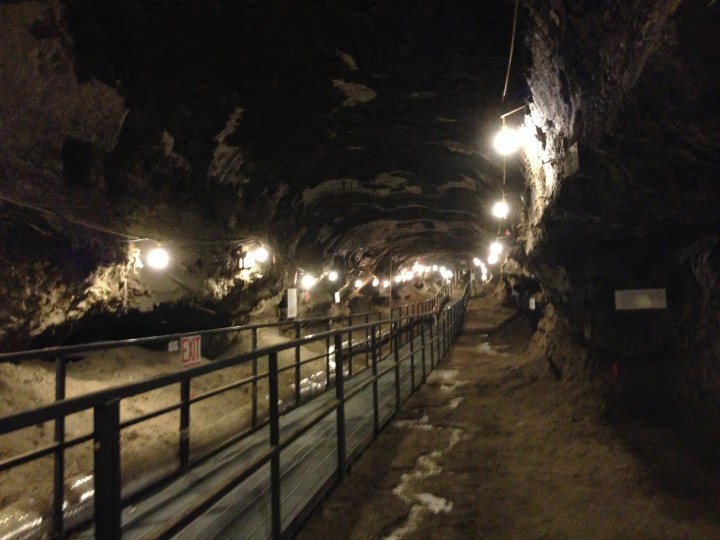
The Permafrost Tunnel Research Facility, dug in the mid-1960s, allows scientists a three-dimensional look at frozen ground. (Credit: Kate Ramsayer/NASA
It’s hard to say what you notice first: the cold or the smell. The cold – it’s kept at a brisk negative 3 degrees Celsius (26.6 degrees Fahrenheit) – is now maintained during the summer with a chiller system. Opening and closing the tunnel door for decades, along with warming outside air temperatures, would otherwise melt the permafrost. The smell, explained our guide Tom Douglas, a geophysicist with the Army who conducts research in the tunnel, is from all the decaying organic material in the walls – plant and animal matter – coming into contact with the air and oxidizing.
Permafrost is ground that stays frozen for more than two years – including the summer months. In cold areas like Central and Northern Alaska, permafrost can build up over millennia, creating a kind of time capsule. In the Permafrost Tunnel, tiny roots of grasses and trees that lived 20,000 to 30,000 years ago drip from the ceiling.
“They’re preserved,” Douglas said. “They tend to be freeze-dried a little bit.” A giant, and surprisingly heavy, mammoth femur was found in the tunnel; horns of bison-like creatures still stick out of the wall. In a wedge of ice cutting through the permafrost, Douglas explained, researchers had melted a sample and found microscopic organisms that hadn’t been previously described.

The tunnel turned up a variety of ice-aged mammal bones – including the giant leg bone of a mammoth. (Credit: Kate Ramsayer/NASA)
The ice wedges themselves are some of the tunnel’s most impressive. They’re created when the surface of the ground freezes and contracts in the winter, creating cracks in the ground. When spring comes, meltwater fills in those cracks, freezing when it reaches the permafrost layer. The next winter, when the ground cracks again, it often does so along the weak areas where it cracked before – and then another round of spring meltwater freezes, pushing the ground apart even further. Over the years, a lattice-work of wedges forms.
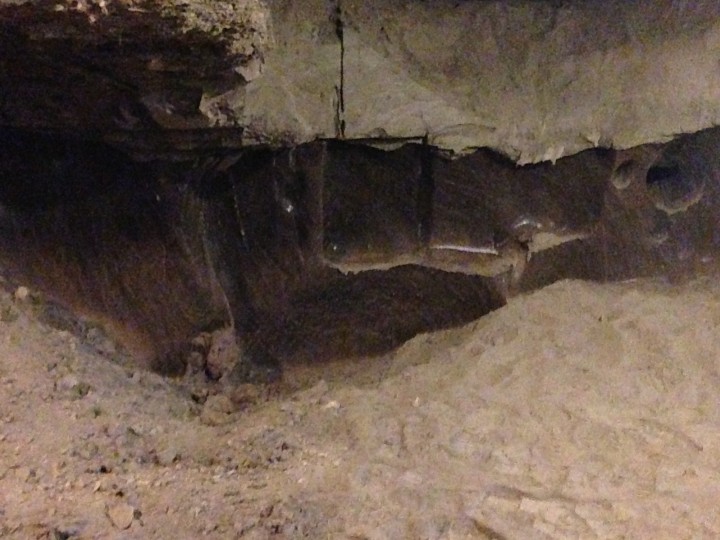
Ice wedges form over centuries, creating polygonal patterns in the permafrost. (Credit: Kate Ramsayer/NASA)
The tunnel was dug in the mid-1960s, Douglas said, and has been used for a variety of research. One question he investigates is how well different radars and surveying equipment can identify underlying permafrost, which is key for building and road construction – you don’t want to build on ground that could thaw.
The necessity for that kind of research was evident on the way back to Fairbanks – the road dips along the hillside, thanks to the dynamic ground underneath.

The North Pole! NASA pilot Tim Williams flew over the pole Wednesday afternoon. It was a cloudy day at 90 degrees north, as seen through the ER-2’s viewsight. (Credit: Tim Williams/NASA)
Fly north from Fairbanks and after a while, you’ll be off the map. Literally, as ER-2 pilot Tim Williams found out Thursday when he flew the NASA aircraft on a mission to the North Pole and back.
“At some point, the map’s not there,” he said at a post-flight debrief Thursday evening.
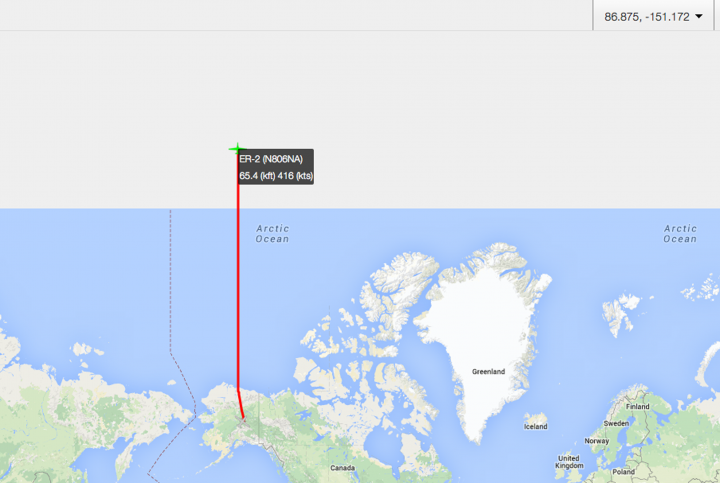
“Here be monsters” – or just map projection issues. Once the ER-2 got above about 89.5 degrees North, the pilot’s map didn’t cover it. Those of us tracking the plane from https://airbornescience.nasa.gov/tracker/ lost the map even earlier.
Williams flew due north along the 150 degrees west longitude line, carrying scientific instruments including MABEL, a laser altimeter that scientists are using to develop software for the upcoming ICESat-2 satellite mission. The goal for the pole-bound trip was to gather data over the spectrum of summer ice – from open water, to degrading ice, to thin ice, to multiyear ice, with some melt ponds on the way.
It was a smooth and cloudy trip up, Williams reported, and through breaks in the clouds he could see cracking ice below.
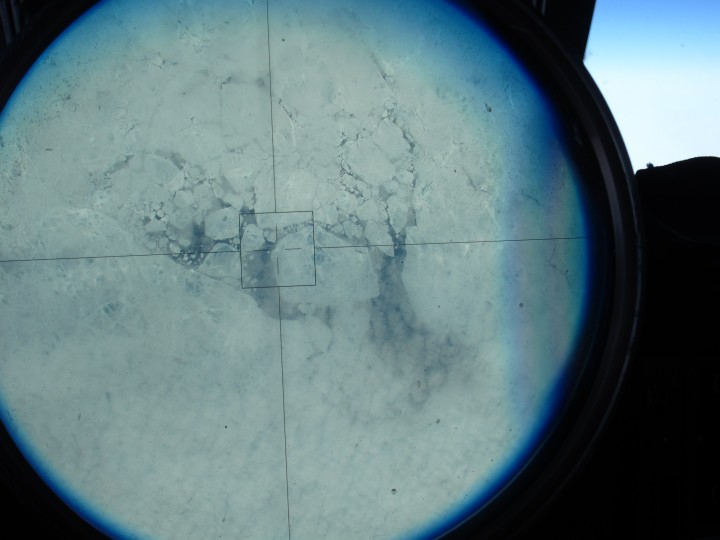
Sea ice, as seen through the ER-2’s viewsight, on the 150 degree latitude line north of Alaska. (Credit: Tim Williams/NASA)
“I expected it to be a lot more solid; it’s not,” he said. “It doesn’t look thick where I could see it.”
After about four hours in the air he reached the pole – 90 degrees latitude. His instincts were to look at the compass onboard, but it was “just a mess, it’s all over the place,” Williams said. At one point, his compass showed 180 degrees opposite from his navigation system.
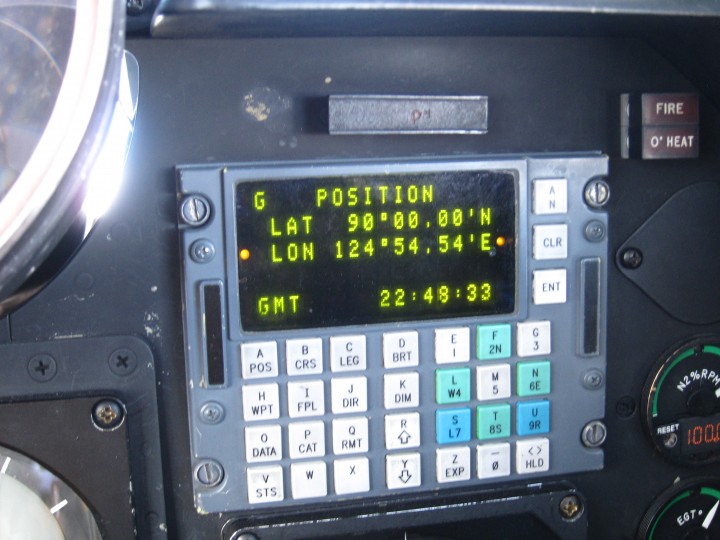
On top of the world! Tim Williams piloted the ER-2 to the North Pole – it’s all south from here. (Credit: Tim Williams/NASA)
Still, he knew which way to go: “When you hit the pole, everything is to the south. So you just make a turn,” Williams said.
He rolled out, circling from the pole, until his navigation system gave him a heading. He found the 140 degree line, and flew back to Fairbanks – headed south.
I didn’t know a hybrid sedan could take a corner that fast. We were sitting in the car, adjacent to the runway where NASA’s ER-2 high-altitude aircraft was about to land. Tim Williams – an ER-2 pilot who will fly later this campaign – was driving, poised to speed down the runway after the plane, in case his fellow pilot needed help avoiding obstacles and gauging conditions.
And as soon as the sleek ER-2 came into view and descended over the runway, we were off. Williams hit the gas (battery?) on the hybrid and swung onto the runway, sending me and my video camera flailing against the passenger-side door as the aircraft buzzed overhead. We raced down the runway, chasing after the plane as it landed, balanced on its two wheels.
On board the ER-2 is MABEL – the Multiple Altimeter Beam Experimental Lidar – a laser altimeter that is gathering data for the ICESat-2 mission. Wednesday’s flight was the first science flight of MABEL’s summer campaign to measure summer sea ice, land ice and more in Alaska.
The day started with a crew and weather briefing at 7 a.m., where pilots Denis Steele and Williams reviewed weather conditions and possible routes with ER-2 Mission Manager Tim Moes, NASA Goddard scientists Thorsten Markus and Kelly Brunt, weather forecasters and others.
With cloudy conditions on the way to the North Pole – covering the dynamic melting edge of the sea ice the campaign hopes to document – the team decided to head southeast out of Fairbanks. That route heads down to the Alaska Peninsula to survey volcanoes, then heads east over glaciers and high-elevation ice fields in south central to southeastern Alaska.
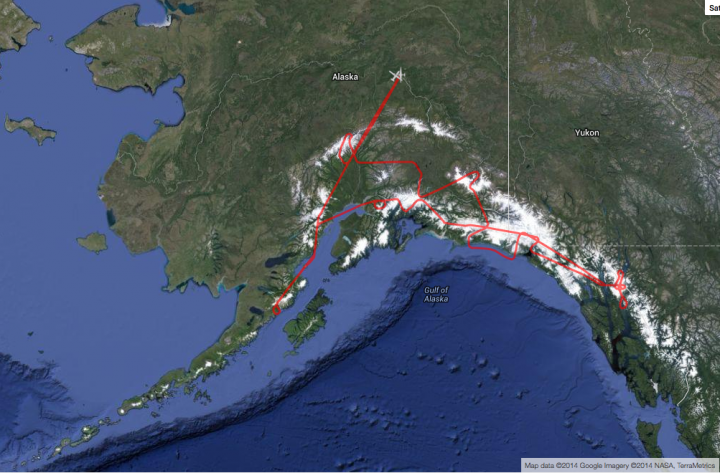
The ER-2, with MABEL on board, flew over volcanoes and glaciers in south central and southeastern Alaska. (http://airbornescience.nasa.gov/tracker/)
With the flight route set, scientists made final checks of the instruments and Steele put on a pressurized suit – necessary for flying at 65,000 feet. He has to “pre-breathe” pure oxygen for an hour before flight, to raise his blood oxygen level.
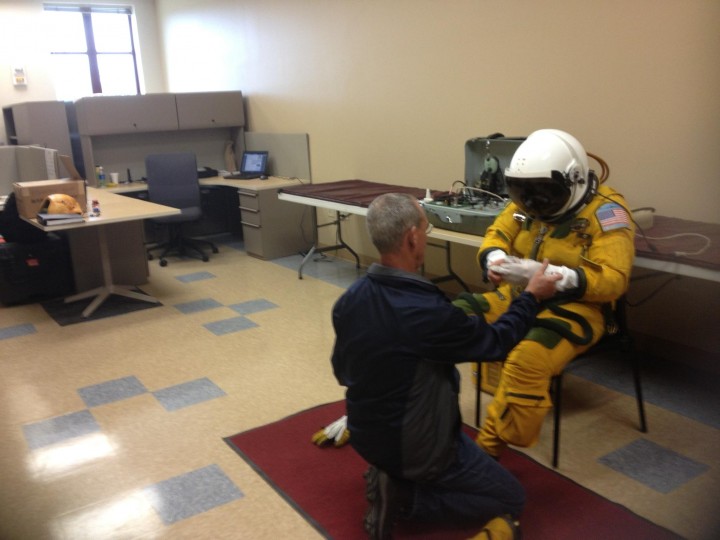
Ryan Ragsdale, engineering technician, helps ER-2 pilot Denis Steele put on a pressurized suit before the flight, which will take him to 65,000 feet. (Credit: Valerie Casasanto/NASA)
Meanwhile, the plane was slowly towed out of the hangar onto the runway at Fort Wainwright and fueled up. The ER-2 crew and Williams went through the preflight checklist, which would be difficult for Steele as the pressurized suit has big gloves and limited dexterity.

ER-2s Denis Steele, in the cockpit, and Tim Williams, checking notes, get ready for the day’s flight. (Credit: Kate Ramsayer/NASA)
After Steele got in and started the engines, he taxied to the end of the runway accompanied by a maintenance van and a chase car: the van so that the crew could grab the bright orange stabilizing wheels, which fall off during takeoff, and the chase car driven by Williams, who supports Steele as necessary.
The ER-2 takes off amazingly fast. One moment it’s at the end of the runway, the next, the roar of the engine sounds. Then, all of a sudden, the aircraft’s in the air, climbing fast to the clouds. The plane disappeared into the clouds before the sound faded, and then the team went back to check the instruments’ vital signs, transmitted from flight.
Just under seven hours later, after flying over a number of key glacier and volcano points north of the Gulf of Alaska, Steele landed the plane. The crew reattached the bright orange stabilizing wheels, and towed him back to the hangar, where scientists were eager to download and view the data.
Steele reported on highlights of the flight – what was cloudy, what was clear – and Moes ended with a reminder of the next early morning meeting to review weather conditions and determine whether the ER-2 would fly another route over Alaska today.
Clouds blanketed much of MABEL’s potential flight routes over the Alaskan Arctic or southern glaciers on Monday, so the ER-2 aircraft stayed in the hangar at Fort Wainwright in Fairbanks, Alaska.
But the MABEL team was busy. They took advantage of a day on the ground by improving the instrument’s new camera. The goal is to take more images like the one below, to help scientists interpret the data from the airborne lidar instrument.
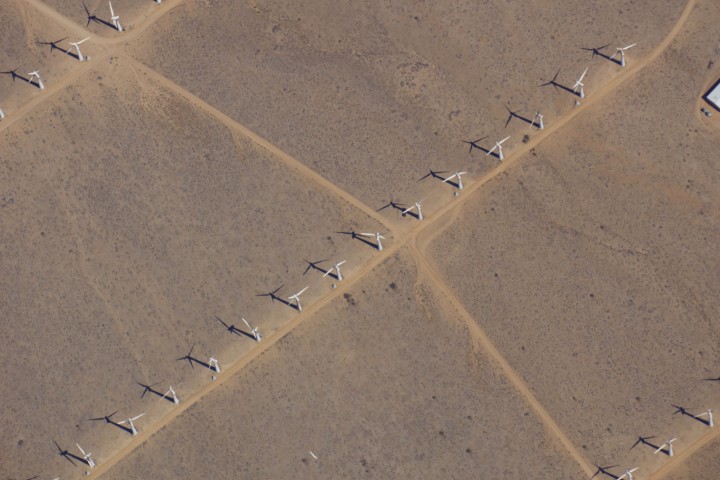
As the ER-2 aircraft traveled from Palmdale, California, to Fairbanks, Alaska, the camera on MABEL took this shot of wind turbines near Bakersfield, California. (Credit: NASA)
It’s the first week of the summer 2014 campaign for MABEL, or the Multiple Altimeter Beam Experimental Lidar, the ICESat-2 satellite’s airborne test instrument. MABEL measures the height of Earth below using lasers and photon-counting devices. This year, the team is using a new camera system to take snapshots of the land, ice and water in parallel with MABEL’s measurements.
The MABEL instrument is nestled snug in the nose cone of the high-altitude ER-2, which has a circular window in the base where the laser and the camera view the ground. To get access to MABEL and the camera, the crew propped up the nose and wheeled it away from the aircraft.

The ER-2 crew rolls the aircraft’s nose — containing MABEL — away from its body, so engineers could work on the instrument. (Credit: Kate Ramsayer/NASA)
The team then carefully slid the instrument out onto a cart, so that MABEL’s on-site engineer and programmer – Eugenia DeMarco and Dan Reed – could work on the camera and ensure the connections were sound.
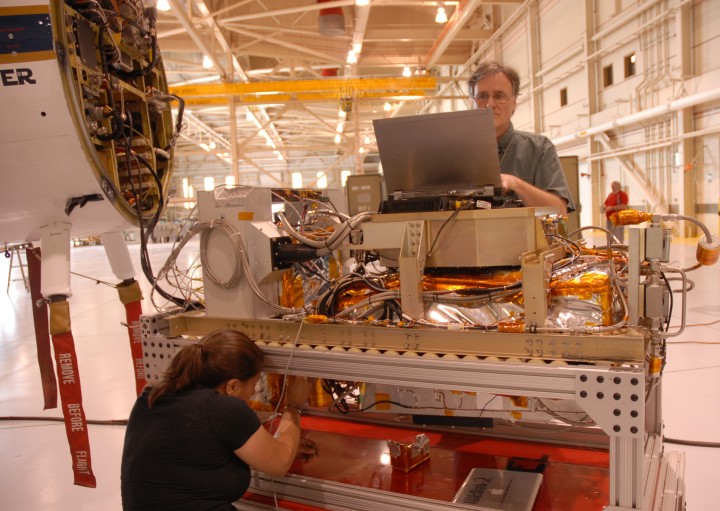
MABEL engineer Eugenia DeMarco and programmer Dan Reed work on improving the new camera system for the instrument. (Credit: Kate Ramsayer/NASA)
When the camera was set to document the terrain from 65,000 feet, the team slid MABEL back to its spot and wheeled the aircraft’s nose back to the rest of its body. They connected the instrument to the plane’s electronics, sealed the plane back up, and are ready to go whenever the weather cooperates.

Luis Rios, with NASA’s ER-2 crew, checks the connections between the MABEL instrument and the aircraft. (Credit: Kate Ramsayer/NASA)
From early July through mid-August 2014, scientist Doug Morton of NASA’s Goddard Space Flight Center in Greenbelt, Maryland, will be flying low over the treetops of interior Alaska. The purpose? First-of-a-kind look at the state’s forests with a portable, airborne imaging system called G-LiHT to map the composition, structure and function of the ecosystem.
According to Morton, key components of the fieldwork include:
“First, we are partnering with the U.S. Forest Service, as directed by the recently-passed Farm Bill, to incorporate remote sensing technology into forest monitoring efforts. Our pilot study will be the first inventory of forests in interior Alaska; a standard ground inventory (as in the lower 48) has always been too costly or logistically challenging to implement.
Second, we will study post-fire recovery, with plans to sample more than 80 percent of all fires in the Tanana region since 1950. Fire is the major agent of change in interior Alaska, and understanding the patterns of forest recovery is essential to gauge the vulnerability/resilience of forests to future climate change.
Third, we will benchmark conditions (topography/permafrost, forest cover, forest composition) across a large portion of the Arctic-Boreal Vulnerability Experiment (ABoVE) science domain.”
Follow Morton through the summer as, Internet connection permitting, he sends updates and photos from the field.